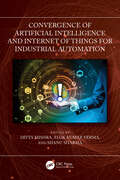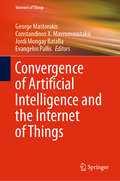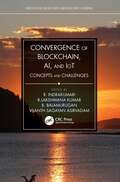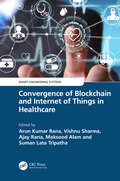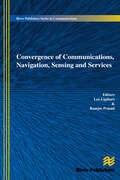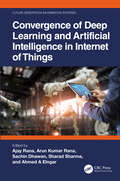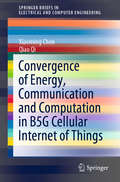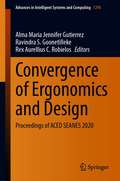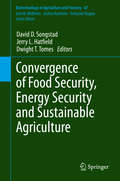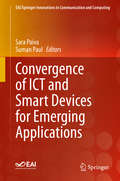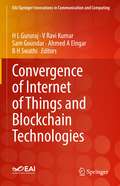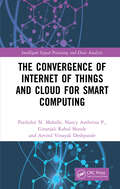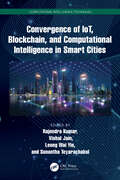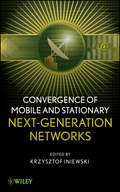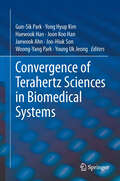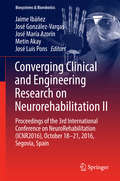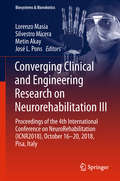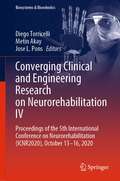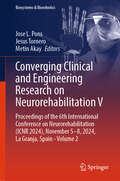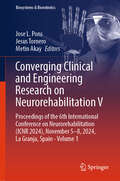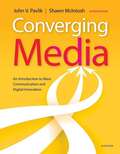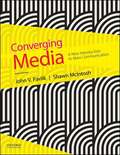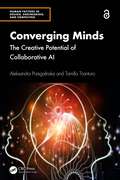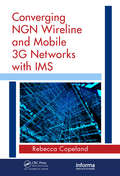- Table View
- List View
Convergence of Artificial Intelligence and Internet of Things for Industrial Automation
by Divya Mishra Alok Kumar Verma Shanu SharmaThis book begins by discussing the fundamentals of Artificial Intelligence, the Internet of Things, and their convergence. It then covers techniques, algorithms, and methods of analysing and processing data over the Artificial Intelligence of Things. The text elaborates on important concepts such as body sensor networks for safety in smart factories, smart energy management, smart robotic assistive systems, and service-oriented smart manufacturing.This book:• Discusses the security and privacy aspect of Artificial Intelligence of Things (AIoT) for smart real-time applications.• Explores challenges and issues of Artificial Intelligence and the Internet of Things in the field of industrial automation.• Includes case studies in Artificial Intelligence of Things (AIoT) convergence for data processing.• Showcases algorithms, techniques, and methods of analysing and processing data over the Artificial Intelligence of Things.• Highlights operation management using human-robot, smart maintenance, and autonomous production.It will serve as an ideal reference text for senior undergraduate, graduate students, and professionals in fields including industrial engineering, production engineering, manufacturing engineering, operations research, and computer engineering.
Convergence of Artificial Intelligence and the Internet of Things (Internet of Things)
by George Mastorakis Constandinos X. Mavromoustakis Jordi Mongay Batalla Evangelos PallisThis book gathers recent research work on emerging Artificial Intelligence (AI) methods for processing and storing data generated by cloud-based Internet of Things (IoT) infrastructures. Major topics covered include the analysis and development of AI-powered mechanisms in future IoT applications and architectures. Further, the book addresses new technological developments, current research trends, and industry needs. Presenting case studies, experience and evaluation reports, and best practices in utilizing AI applications in IoT networks, it strikes a good balance between theoretical and practical issues. It also provides technical/scientific information on various aspects of AI technologies, ranging from basic concepts to research grade material, including future directions. The book is intended for researchers, practitioners, engineers and scientists involved in the design and development of protocols and AI applications for IoT-related devices. As the book covers a wide range of mobile applications and scenarios where IoT technologies can be applied, it also offers an essential introduction to the field.
Convergence of Blockchain, AI, and IoT: Concepts and Challenges (Innovations in Big Data and Machine Learning)
by R. IndrakumariConvergence of Blockchain, AI, and IoT: Concepts and Challenges discusses the convergence of three powerful technologies that play into the digital revolution and blur the lines between biological, digital, and physical objects. This book covers novel algorithms, solutions for addressing issues in applications, security, authentication, and privacy. The book provides an overview of the clinical scientific research enabling smart diagnosis equipment through AI. It presents the role these technologies play in augmented reality and blockchain, covers digital currency managed with bitcoin, and discusses deep learning and how it can enhance human thoughts and behaviors. Targeted audiences range from those interested in the technical revolution of blockchain, big data and the Internet of Things, to research scholars and the professional market.
Convergence of Blockchain and Internet of Things in Healthcare (Smart Engineering Systems: Design and Applications)
by Arun Kumar Rana, Vishnu Sharma, Ajay Rana, Maksud Alam and Suman Lata TripathiThe Internet of Things (IoT) and blockchain are two new technologies that combine elements in many ways. A system where the virtual and physical worlds interact is created by integrating pervasive computing, ubiquitous computing, communication technologies, sensing technologies, Internet Protocol, and embedded devices. A massive number of linked devices and vast amounts of data present new prospects for developing services that can directly benefit the economy, environment, society, and individual residents. Due to the size of IoT and insufficient data security, security breaches may have a huge impact and negative effects. IoT not only connects gadgets but also people and other entities, leaving every IoT component open to a wide variety of assaults. The implementation and application of IoT and blockchain technology in actual scientific, biomedical, and data applications are covered in this book. The book highlights important advancements in health science research and development by applying the distinctive capabilities inherent to distributed ledger systems. Each chapter describes the current uses of blockchain in real-world data collection, medicine development, device tracking, and more meaningful patient interaction. All of these are used to create opportunities for expanding health science research. This paradigm change is studied from the perspectives of pharmaceutical executives, biotechnology entrepreneurs, regulatory bodies, ethical review boards, and blockchain developers.Key Features: Provides a foundation for the implementation process of blockchain and IoT devices based on healthcare-related technology Image processing and IoT device researchers can correlate their work with other requirements of advanced technology in the healthcare domain Conveys the latest technology, including artificial intelligence and machine learning, in healthcare-related technology Useful for the researcher to explore new things like security, cryptography, and privacy in healthcare related technology Tailored for people who want to start in healthcare-related technology with blockchain and IoT This book is primarily for senior undergraduates, graduate students, and academic researchers in the fields of electrical engineering, electronics and communication engineering, computer science and engineering, and biomedical engineering.
Convergence of Communications, Navigation, Sensing and Services (River Publishers Series In Communications Ser.)
by Leo Ligthart Ramjee PrasadActivities on integrated communications, navigation, sensing and services are urgently needed in a wide range of human-centered and/or device-centered system applications. They require a multi-disciplinary approach. It is foreseen that the economic scale of these activities are comparable with the present scale of wireless communications. The area in which systems operate can vary from personal area network to global network.This book covers the following topics;• CONASENSE Architecture• Performance Analyses of Integrated Communication Systems• Cognitive Radio Networks• Brain Computer Interfacing• Quality Improvement of Generic Services• Machine to Machine communications• Chip to Chip CommunicationsThus, the multi-disciplinary approach get attention in the book.
Convergence of Deep Learning and Artificial Intelligence in Internet of Things (Future Generation Information Systems)
by Arun Kumar Rana Ajay Rana Sachin Dhawan Sharad Sharma Ahmed A. ElngarThis book covers advances and applications of smart technologies including the Internet of Things (IoT), artificial intelligence, and deep learning in areas such as manufacturing, production, renewable energy, and healthcare. It also covers wearable and implantable biomedical devices for healthcare monitoring, smart surveillance, and monitoring applications such as the use of an autonomous drone for disaster management and rescue operations. It will serve as an ideal reference text for senior undergraduate, graduate students, and academic researchers in the areas such as electrical engineering, electronics and communications engineering, computer engineering, and information technology. • Covers concepts, theories, and applications of artificial intelligence and deep learning, from the perspective of the Internet of Things. • Discusses powers predictive analysis, predictive maintenance, and automated processes for making manufacturing plants more efficient, profitable, and safe. • Explores the importance of blockchain technology in the Internet of Things security issues. • Discusses key deep learning concepts including trust management, identity management, security threats, access control, and privacy. • Showcases the importance of intelligent algorithms for cloud-based Internet of Things applications. This text emphasizes the importance of innovation and improving the profitability of manufacturing plants using smart technologies such as artificial intelligence, deep learning, and the Internet of Things. It further discusses applications of smart technologies in diverse sectors such as agriculture, smart home, production, manufacturing, transport, and healthcare.
Convergence of Energy, Communication and Computation in B5G Cellular Internet of Things (SpringerBriefs in Electrical and Computer Engineering)
by Xiaoming Chen Qiao QiThis book focuses on the convergence of energy, communication and computation in the beyond 5G (B5G) cellular Internet of Things (IoT). It addresses both theory and techniques, with more weight placed on the latter. This is achieved by providing in-depth studies on a number of major topics such as wireless power transfer, non-orthogonal multiple access, massive multiple-input multiple-output, and over-air computation. In turn, four typical convergence scenarios are studied in detail: the convergence of energy and communication, convergence of energy and computation, convergence of communication and computation, and convergence of energy, communication and computation. The comprehensive and systematic coverage of key techniques in the convergence of energy, communication and computation in the B5G cellular IoT is one of the book’s major features, making it particularly well suited for readers who are interested in learning about practical solutions in B5G wireless networks. Accordingly, the book offers a valuable resource for researchers, engineers, and graduate students in the fields of information engineering, telecommunications engineering, computer engineering, etc.
Convergence of Ergonomics and Design: Proceedings of ACED SEANES 2020 (Advances in Intelligent Systems and Computing #1298)
by Alma Maria Jennifer Gutierrez Ravindra S. Goonetilleke Rex Aurellius C. RobielosThis book presents the proceedings of the Joint Conference of the Asian Council on Ergonomics and Design and Southeast Asian Network of Ergonomics Societies (ACED SEANES), held on December 2-4, 2020. By highlighting the latest theories and models, as well as cutting-edge technologies and applications, and by combining findings from a range of disciplines including engineering, design, robotics, healthcare, management, computer science, human biology and behavioral science, it provides researchers and practitioners alike with a comprehensive, timely guide on human factors and ergonomics. It also offers an excellent source of innovative ideas to stimulate future discussions and developments aimed at applying knowledge and techniques to optimize system performance, while at the same time promoting the health, safety and wellbeing of individuals. The proceedings include papers from researchers and practitioners, scientists and physicians, institutional leaders, managers and policy makers that contribute to constructing the Human Factors and Ergonomics approach across a variety of methodologies, domains and productive sectors.
Convergence of Food Security, Energy Security and Sustainable Agriculture (Biotechnology in Agriculture and Forestry #67)
by Jerry L. Hatfield David D. Songstad Dwight T. TomesThis volume examines the interrelated fields of food security, energy security and sustainable agriculture as the key to a stable global agricultural platform and is arranged in six parts The first part is focused on policy considerations relating to food and energy security and sustainable agriculture The authors from this part include Former Under Secretary of Agriculture Gale Buchanan, Former Under Secretary of Energy Raymond Orbach (Chapter 1), Stephen Hughes, Bryan Moser and William Gibbons (Chapter 2) and Thomas Redick (Chapter 3) Part II addresses soil and water, which are two of the key components in secure and sustainable food production Authors from this part are Jerry Hatfield (Chapter 4) and Mahbub Alam, Sharon Megdal et al. (Chapter 5) The third part covers sustainable and secure food production specifically addressing genetically modified traits in Chapter 6 (James McWilliams) and omega-3 fatty acids in Chapter 7 (Jay Whelan et al. ) Agronomic implications relative to food security and sustainable agriculture are described in Part IV Authors include Ravi Sripada, Pradip Das et al. (Chapter 8), Duska Stojsin, Kevin Matson and Richard Leitz (Chapter 9) and S. H. Lee, David Clay and Sharon Clay (Chapter 10) International sustainable agriculture and food security is addressed in Part V with authors Jeff Vitale and John Greenplate (Chapter 11), Julie Borlaug et al. (Chapter 12) and Sylvester Oikeh et al. (Chapter 13) The final part covers the use of chemicals in sustainable agriculture and food/energy security with Leonard Gianessi and Ashley Williams communicating the role of herbicides and Harold Reetz emphasizing the importance of fertilizers both in maximizing crop yields to maintain a sustainable secure source for food production.
Convergence of ICT and Smart Devices for Emerging Applications (EAI/Springer Innovations in Communication and Computing)
by Sara Paiva Suman PaulThis book focuses on recent topics related to the convergence of information and communication technologies (ICT) and computing with smart devices. Domain areas of application include social, industrial, business development, and day to day life aspects. This book presents chapters related to the aforementioned topics including case studies showcasing future technological trends and challenges. Topics social inclusion solutions and social changes; smart devices and applications for day to day life; smart IoT and applications; and smart cities solutions. The book is applicable to researchers, students, professionals, and professors in a wide range of fields.Focuses on recent developments in ICT and smart devices that pose a clear benefit for users;Presents applications of ICT in education, health, electronics, communication, networking, computing, tourism, transportation;Appeals to researchers, academics, and professionals in a cross section of disciplines.
Convergence of Internet of Things and Blockchain Technologies (EAI/Springer Innovations in Communication and Computing)
by H L Gururaj V Ravi Kumar Sam Goundar Ahmed A Elngar B H SwathiThis book presents chapters from diverse range of authors on different aspects of how Blockchain and IoT are converging and the impacts of these developments. The book provides an extensive cross-sectional and multi-disciplinary look into this trend and how it affects artificial intelligence, cyber-physical systems, and robotics with a look at applications in aerospace, agriculture, automotive, critical infrastructures, healthcare, manufacturing, retail, smart transport systems, smart cities, and smart healthcare. Cases include the impact of Blockchain for IoT Security; decentralized access control systems in IoT; Blockchain architecture for scalable access management in IoT; smart and sustainable IoT applications incorporating Blockchain, and more. The book presents contributions from international academics, researchers, and practitioners from diverse perspectives.Presents how Blockchain and IoT are converging and the impacts of these developments on technology and its application;Discusses IoT and Blockchain from cross-sectional and multi-disciplinary perspectives;Includes contributions from researchers, academics, and professionals from around the world.
The Convergence of Internet of Things and Cloud for Smart Computing (Intelligent Signal Processing and Data Analysis)
by Parikshit N. Mahalle Gitanjali Rahul Shinde Nancy Ambritta P. Arvind Vinayak DeshpandeThis book presents the know-how of the real-time IoT application development activity including a basic understanding of the IoT architecture, use cases, smart computing, and the associated challenges in design and development of the IoT system. All the technical details related to protocol stack, technologies, and platforms used for the implementation are explained. It further includes techniques and case studies that include smart computing on the IoT–Cloud models along with test beds for experimentation purposes. The book aims at setting up the groundwork for the creation of applications that can help make day-to-day tasks simpler by meeting the needs of varied sectors like education, health care, agriculture, and so forth. Features: • Covers IoT cloud convergence with a focus on complex industrial IoT case studies. • Discusses the broad background of IoT–Cloud convergence architectures and its fundamentals along with resource provisioning mechanisms. • Emphasizes the use of context in developing context-aware IoT solutions. • Presents a novel C-model that explains the IoT application development phases. • Discusses a simplified convergence model that depicts the role of Cloud in an IoT application. This book aims at graduate students, researchers, and professionals getting started in the IoT field.
Convergence of IoT, Blockchain, and Computational Intelligence in Smart Cities (Computational Intelligence Techniques)
by Rajendra Kumar Vishal Jain Leong Wai Yie Sunantha TeyarachakulThis edited book presents an insight for modelling, procuring, and building the smart city plan using the Internet of Things (IoT) and a security framework using blockchain technology. The applications of Li-Fi and 5G in smart cities are included, along with their implementation, challenges, and advantages. This book focuses on the use of IoT and blockchain in the day-to-day transparent and recorded activities of citizens of smart cities like, smart citizen management. The future for upgrading the system as per technological advancements is also discussed. This book: integrates IoT, blockchain, Li-Fi, and 5G in smart city implementation covers smart supply chain management using IoT outlines the state-of-the-art and sustainable implementation of smart cities and practical challenges includes sustainable development of smart cities presents detailed explanation of case studies of smart cities of developed countries and developing countries and their comparisons This book is aimed at researchers and graduate students in Artificial Intelligence, Urban Planning, and Information Technology Systems and Management.
Convergence of Mobile and Stationary Next-Generation Networks
by Krzysztof IniewskiThe Only Resource to Cover Wireless, Wireline, and Optical Networks in One VolumeMobile and stationary next-generation networks that access the photonic core are destined to become as ubiquitous as traditional telephone networks. These networks must efficiently provide adequate network quality to multimedia applications with high bandwidth and strict quality-of-service requirements, as well as seamlessly integrate mobile and fixed architectures. Today's engineering students must be properly prepared to meet the challenges of next-generation network development and deployment.Featuring contributions from top industrial experts and academic professors, this authoritative work provides a comprehensive introduction to next-generation networks. It explains wireless networks such as wireless local area networks (WLAN), wireless personal area networks (WPAN), wireless access, 3G/4G cellular, and RF transmission, as well as optical networks like long-haul and metropolitan networks, optical fiber, photonic devices, and VLSI chips. Rather than focusing on heavy math or physical details, this resource explores how the technology is being used. It describes access and transport network layer technologies while also discussing the network and services aspects.Chapter coverage includes:Fiber-wireless networks: technologies, architectures, and future challengesPacket backhaul networkPoint-to-point microwave backhaulFourth-generation broadband: paving the road to Gbit/s with copperDynamic bandwidth allocation in EPON and GPONNext-generation ethernet passive optical networks: 10G-EPONPower line communications and smart gridsSignaling for multimedia conferencing in 4G: architecture, evaluation, and issuesSelf-coexistence and security in cognitive radio networksMobile WiMAXUWB personal area networks--MIMO extensionsNext-generation integrated metropolitan-access network: technology integration and wireless convergenceResilient burst ring: a novel technology for the next-generation metropolitan area networksFilled with illustrations and practical examples from industry, this book will be invaluable to engineers and researchers in industry and academia, as well as senior undergraduate and graduate students, marketing and management staff, photonics physicists, and chip designers.
Convergence of Telecommunications and Broadcasting in Japan, United Kingdom and Germany: Technological Change, Public Policy and Market Structure
by Koichiro Agata Kiyoshi NakamuraThe convergence of telecommunications and broadcasting raises many questions. What form will convergence take in the future? When convergence produces new opportunities in the information, education and entertainment markets, what sort of rules of the game will be required? How will the players behave in these new markets? What policies might be needed?
Convergence of Terahertz Sciences in Biomedical Systems
by Gun-Sik Park Haewook Han Jaewook Ahn Joo-Hiuk Son Joon Koo Han Woong-Yang Park Yong Hyup Kim Young Uk JeongRecent technological breakthrough in the field of Terahertz radiation has triggered new applications in biology and biomedicine. Particularly, biological applications are based on the specific spectroscopic fingerprints of biological matter in this spectral region. Historically with the discovery of new electromagnetic wave spectrum, we have always discovered new medical diagnostic imaging systems. The use of terahertz wave was not realized due to the absence of useful terahertz sources. Now after successful generation of THz waves, it is reported that a great potential for THz wave exists for its resonance with bio-molecules. There are many challenging issues such as development of THz passive and active instrumentations, understanding of THz-Bio interaction for THz spectroscopy, THz-Bio nonlinear phenomena and safety guideline, and THz imaging systems. Eventually the deeper understanding of THz-Bio interaction and novel THz systems enable us to develop powerful THz biomedical imaging systems which can contribute to biomedical industry. This is a truly interdisciplinary field and convergence technology where the communication between different disciplines is the most challenging issue for the success of the great works. One of the first steps to promote the communications in this convergence technology would be teaching the basics of these different fields to the researchers in a plain language with the help of Convergence of Terahertz Science in Biomedical Systems which is considered to be 3-4th year college students or beginning level of graduate students. Therefore, this type of book can be used by many people who want to enter or understand this field. Even more it can be used for teaching in universities or research institutions.
Converging Clinical and Engineering Research on Neurorehabilitation II: Proceedings of the 3rd International Conference on NeuroRehabilitation (ICNR2016), October 18-21, 2016, Segovia, Spain (Biosystems & Biorobotics #15)
by Metin Akay José González-Vargas Jaime Ibáñez José Luis Pons José María AzorínThe book reports on advanced topics in the areas of neurorehabilitation research and practice. It focuses on new methods for interfacing the human nervous system with electronic and mechatronic systems to restore or compensate impaired neural functions. Importantly, the book merges different perspectives, such as the clinical, neurophysiological, and bioengineering ones, to promote, feed and encourage collaborations between clinicians, neuroscientists and engineers. Based on the 2016 International Conference on Neurorehabilitation (ICNR 2016) held on October 18-21, 2016, in Segovia, Spain, this book covers various aspects of neurorehabilitation research and practice, including new insights into biomechanics, brain physiology, neuroplasticity, and brain damages and diseases, as well as innovative methods and technologies for studying and/or recovering brain function, from data mining to interface technologies and neuroprosthetics. In this way, it offers a concise, yet comprehensive reference guide to neurosurgeons, rehabilitation physicians, neurologists, and bioengineers. Moreover, by highlighting current challenges in understanding brain diseases as well as in the available technologies and their implementation, the book is also expected to foster new collaborations between the different groups, thus stimulating new ideas and research directions.
Converging Clinical and Engineering Research on Neurorehabilitation III: Proceedings of the 4th International Conference on NeuroRehabilitation (ICNR2018), October 16-20, 2018, Pisa, Italy (Biosystems & Biorobotics #21)
by José L. Pons Metin Akay Silvestro Micera Lorenzo MasiaThe book reports on advanced topics in the areas of neurorehabilitation research and practice. It focuses on new methods for interfacing the human nervous system with electronic and mechatronic systems to restore or compensate impaired neural functions. Importantly, the book merges different perspectives, such as the clinical, neurophysiological, and bioengineering ones, to promote, feed and encourage collaborations between clinicians, neuroscientists and engineers. Based on the 2018 International Conference on Neurorehabilitation (ICNR 2018) held on October 16-20, 2018, in Pisa, Italy,, this book covers various aspects of neurorehabilitation research and practice, including new insights into biomechanics, brain physiology, neuroplasticity, and brain damages and diseases, as well as innovative methods and technologies for studying and/or recovering brain function, from data mining to interface technologies and neuroprosthetics. In this way, it offers a concise, yet comprehensive reference guide to neurosurgeons, rehabilitation physicians, neurologists, and bioengineers. Moreover, by highlighting current challenges in understanding brain diseases as well as in the available technologies and their implementation, the book is also expected to foster new collaborations between the different groups, thus stimulating new ideas and research directions.
Converging Clinical and Engineering Research on Neurorehabilitation IV: Proceedings of the 5th International Conference on Neurorehabilitation (ICNR2020), October 13–16, 2020 (Biosystems & Biorobotics #28)
by Diego Torricelli Metin Akay Jose L. PonsThe book reports on advanced topics in the areas of neurorehabilitation research and practice. It focuses on new methods for interfacing the human nervous system with electronic and mechatronic systems to restore or compensate impaired neural functions. Importantly, the book merges different perspectives, such as the clinical, neurophysiological, and bioengineering ones, to promote, feed and encourage collaborations between clinicians, neuroscientists and engineers. Based on the 2020 International Conference on Neurorehabilitation (ICNR 2020) held online on October 13-16, 2020, this book covers various aspects of neurorehabilitation research and practice, including new insights into biomechanics, brain physiology, neuroplasticity, and brain damages and diseases, as well as innovative methods and technologies for studying and/or recovering brain function, from data mining to interface technologies and neuroprosthetics. In this way, it offers a concise, yet comprehensive reference guide to neurosurgeons, rehabilitation physicians, neurologists, and bioengineers. Moreover, by highlighting current challenges in understanding brain diseases as well as in the available technologies and their implementation, the book is also expected to foster new collaborations between the different groups, thus stimulating new ideas and research directions.
Converging Clinical and Engineering Research on Neurorehabilitation V: Proceedings of the 6th International Conference on Neurorehabilitation (ICNR 2024), November 5–8, 2024, La Granja, Spain - Volume 2 (Biosystems & Biorobotics #32)
by Jose L. Pons Jesus Tornero Metin AkayThe book reports on advanced topics in the areas of neurorehabilitation research and practice. It focuses on new methods for interfacing the human nervous system with electronic and mechatronic systems to restore or compensate impaired neural functions. Importantly, the book merges different perspectives, such as the clinical, neurophysiological, and bioengineering ones, to promote, feed and encourage collaborations between clinicians, neuroscientists and engineers. Based on the 2024 International Conference on Neurorehabilitation (ICNR2024) held in La Granja, Spain on November 5-8, 2024, this book covers various aspects of neurorehabilitation research and practice, including new insights into biomechanics, brain physiology, neuroplasticity, and brain damages and diseases, as well as innovative methods and technologies for studying and/or recovering brain function, from data mining to interface technologies and neuroprosthetics. In this way, it offers a concise, yet comprehensive reference guide to neurosurgeons, rehabilitation physicians, neurologists, and bioengineers. Moreover, by highlighting current challenges in understanding brain diseases as well as in the available technologies and their implementation, the book is also expected to foster new collaborations between the different groups, thus stimulating new ideas and research directions.
Converging Clinical and Engineering Research on Neurorehabilitation V: Proceedings of the 6th International Conference on Neurorehabilitation (ICNR 2024), November 5–8, 2024, La Granja, Spain - Volume 1 (Biosystems & Biorobotics #31)
by Jose L. Pons Jesus Tornero Metin AkayThe book reports on advanced topics in the areas of neurorehabilitation research and practice. It focuses on new methods for interfacing the human nervous system with electronic and mechatronic systems to restore or compensate impaired neural functions. Importantly, the book merges different perspectives, such as the clinical, neurophysiological, and bioengineering ones, to promote, feed and encourage collaborations between clinicians, neuroscientists and engineers. Based on the 2024 International Conference on Neurorehabilitation (ICNR2024) held in La Granja, Spain on November 5-8, 2024, this book covers various aspects of neurorehabilitation research and practice, including new insights into biomechanics, brain physiology, neuroplasticity, and brain damages and diseases, as well as innovative methods and technologies for studying and/or recovering brain function, from data mining to interface technologies and neuroprosthetics. In this way, it offers a concise, yet comprehensive reference guide to neurosurgeons, rehabilitation physicians, neurologists, and bioengineers. Moreover, by highlighting current challenges in understanding brain diseases as well as in the available technologies and their implementation, the book is also expected to foster new collaborations between the different groups, thus stimulating new ideas and research directions.
Converging Media: An Introduction To Mass Communication And Digital Innovation
by Shawn McIntosh John PavlikIndustry. Culture. Technology. They have come together. What's next? From reading news on tablets to video calling on smartphones, digital media has changed the ways in which we communicate. Placing convergence at the center of the discussion, Converging Media: An Introduction to Mass Communication, Seventh Edition, uses the technologies we employ every day to explain our current media environment-and to consider where we might be headed.
Converging Media
by John V. Pavlik Shawn McIntoshIndustry. Culture. Technology. It's time they came together. From reading news on tablets to video calling on smartphones, digital media has changed the ways in which we communicate. Placing convergence at the center of the discussion, Converging Media: A New Introduction to Mass Communication, Sixth Edition, uses the technologies we employ every day to explain our current media environment--and to consider where we might be headed.
Converging Minds: The Creative Potential of Collaborative AI (Human Factors in Design, Engineering, and Computing)
by Aleksandra Przegalinska Tamilla TriantoroThis groundbreaking book explores the power of collaborative AI in amplifying human creativity and expertise. Written by two seasoned experts in data analytics, AI, and machine learning, the book offers a comprehensive overview of the creative process behind AI-powered content generation. It takes the reader through a unique collaborative process between human authors and various AI-based topic experts, created, prompted, and fine-tuned by the authors.This book features a comprehensive list of prompts that readers can use to create their own ChatGPT-powered topic experts. By following these expertly crafted prompts, individuals and businesses alike can harness the power of AI, tailoring it to their specific needs and fostering a fruitful collaboration between humans and machines. With real-world use cases and deep insights into the foundations of generative AI, the book showcases how humans and machines can work together to achieve better business outcomes and tackle complex challenges. Social and ethical implications of collaborative AI are covered and how it may impact the future of work and employment. Through reading the book, readers will gain a deep understanding of the latest advancements in AI and how they can shape our world.Converging Minds: The Creative Potential of Collaborative AI is essential reading for anyone interested in the transformative potential of AI-powered content generation and human-AI collaboration. It will appeal to data scientists, machine learning architects, prompt engineers, general computer scientists, and engineers in the fields of generative AI and deep learning.Chapter 1 of this book is freely available as a downloadable Open Access PDF at http://www.taylorfrancis.com under a Creative Commons [Attribution- No Derivatives (CC-BY -ND)] 4.0 license.
Converging NGN Wireline and Mobile 3G Networks with IMS: Converging NGN and 3G Mobile
by Rebecca CopelandFocusing on the future network architecture and its main principles, Converging NGN Wireline and Mobile 3G Networks with IMS provides a comprehensive view of the methods, functions, network elements, and the interfaces among them that enable the building of a service agnostic and access agnostic session control layer based on the IMS standar
